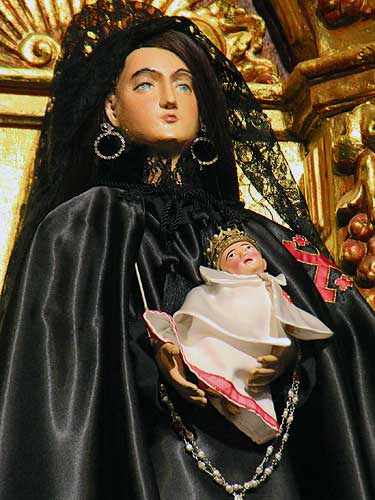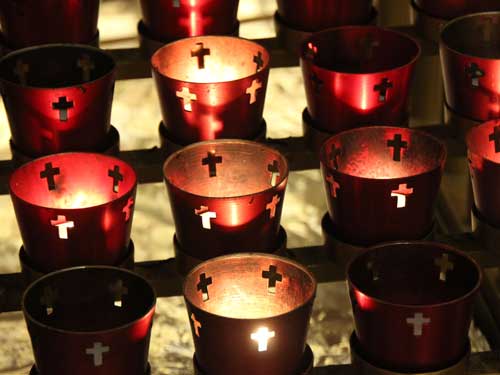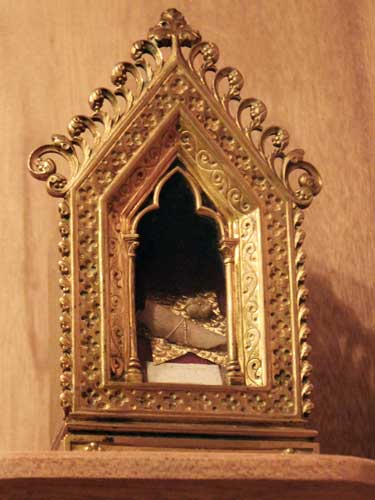LOS ALAMOS & SANTA FE (Day 3 - part 5)
At the far end of the church was an altar screen (or reredos) called 'Saints of the Americas,' created by Robert Lentz (an American Franciscan friar and religious icon painter) in 1986 for the cathedral's 100th anniversary.

A statue of St. Francis of Assisi is surrounded by painted images of saints of the New World.

Above the altar is the 6-foot tall replica of the San Damiano Crucifix found in Assisi, Italy.

To celebrate the anniversary, old artifacts and furnishings were recovered and restored... including this 18th-century statue of St. Francis. Originally from the old church, it was given away to the San Francisco Church in Golden (New Mexico) after the new cathedral was built. To get it back, the church had to pay a LOT of money. According to the rector at the time, "The priest gave the statue back, but the right arm was missing. The arms are removable, and he wanted $500 for the right arm!”

Saint Frances Xavier Cabrini (also called Mother Cabrini, 1850 - 1917)founded the Missionary Sisters of the Sacred Heart, a Catholic institute that was a major support to Italian immigrants.

St. Louis Bertrand (1526 - 1581) was known as the Apostle to the Americas. At an early age, he wanted a Dominican Friar and eventually devoted himself to missionary work in South America.

St. Rose of Lima (aka Isabel Flores de Olivia, 1586 - 1617) grew up in an abusive household in Peru. She identified deeply with the suffering Christ and longed to become a nun. To mar her beauty and deter men, she rubber her face with pepper to make it blister and cropped her hair. She lived a life of extreme prayer, fasting and penance. One time, she burned her hands as a self-imposed act of penance. She would wear a heavy silver crown with spikes that could pierce her flesh. The spikes sometimes become so lodged in her skull that the crown was difficult to remove. She died at the age of 31 after a painful illness.
We entered the side chapel which was kept from the old La Parroquia church from 1714.

Where as 'conquistadora' would usually be translated as a female conqueror, here it is translated as Lady of Peace. Apparently it all depends on what side you are on.

This current reredos was constructed from the material from a pre-1800 one that had sat on the high altar. Originally it was made into two separate screens which were combined into this one in the 1950's.

The crown at the top means this altarscreen is dedicated to the Blessed Virgin Mary.

The main feature of the chapel is La Conquistadora herself. Slso known as Our Lady of the Assumption, Our Lady of the Rosary, and Our Lady of Peace, her claim to fame is being the oldest representation of the Virgin Mary in the New World. She was carved from willow in Spain sometime in the early 1600's, was carried to Santa Fe in 1625 by Franciscan Friars. She was saved from destruction during the 1680 Pueblo Revolt and hid in Texas for 12 years until being returned.
She is a statue that is meant to be clothed, and she apparently has an extensive wardrobe.

(Here is what she wore in the summer of 2013)

The Lamb (a symbol for Jesus) sits on the Book with the Seven Seals (Book of Revelation or the Apocalypse). The Greek word apocalypse simply means 'uncovering' or a disclosure of knowledge. In Christianity, it has come to refer to the ultimate victory of good over evil and the end of days. In order for Jesus Christ to return to earth (the Second Coming) and establish his reign of justice and peace, a series of cataclysmic events must first take place, as described by the seven seals. Each one gets progressively worse and more devastating in order to prepare the world for the new kingdom.
The first four seals are the Four Horsemen, each with their own specific mission.... the white horse reveals false prophets; the red horse is a great war; the black horse is famine; the pale horse is plague and death. The fifth seal is persecution and martyrdom.The sixth is heavenly signs such a devastating earthquake and the moon turning to blood. And the seventh cues angelic trumpeters who in turn bring on more cataclysmic events... hail, fire, a meteor hitting the ocean, darkening the sun and so on. Wow, scary stuff! And from such an innocent looking lamb!

St. Bernard of Clairvaux (died 1153) and St. Augustin of Hippo (died 430)

St. Diego of Alcala (died 1463)

Along the side wall of the chapel were many reliquaries, each housing the physical remains (mostly bones) of various saints or other religious figures.


This holds a tiny bone fragment from St. Francis

This tiny swatch of cloth is a piece of the habit from Blessed Maria de Jesus (1891 - 1974).

The pieces get a bit bigger with some bone and a tooth from St. Justin (100 - 165).

And the highlight... a piece of veil from the Blessed Virgin Mary herself.

This oil paintings once graced the old church. "The Agony in the Garden" was created by Pascual Pérez in 1710. It was brought by oxcart from Mexico in several rolls (note the seam) and was stitched back together here. (Click for a larger view)

The scene depicts Jesus late at night in the Garden of Gethsemane prior to his arrest. He has already been betrayed, none of his disciples have remained awake with him, and and he knows he will soon be crucified. He's certainly handling it better than I would!

The alove in this side chapel contains the history of the archbishops...

... including good ol' Jean Baptiste ... or apparently John Baptist in English.

Sometimes it's what is missing that is more interesting than what is present. Who was removed? And why?

This large French-made crucifixion scene was pulled from storage in a bell tower during the hundred year anniversary and placed above the confessionals.
Just a block away was the Loretto Chapel. Remember the nuns (pictured on the bronze doors of the cathedral) who travelled from Kentucky in 1853 to help Jean Baptiste Lamy? Yup, this is where they ended up. Starting out in just a one room adobe building, they founded a Catholic girls' school.
The chapel came along some 20 years later, built from 1873 - 78. Called the Our Lady of Light Chapel, it was constructed in the Gothic Revival style and patterned after Sainte Chapelle in Paris. The school remained open until 1968, and in 1971, it was sold to a private family. Today it serves as a museum but can also be rented out for weddings, concerts, services, etc.

The chapel, complete with spires, buttresses and stained glass windows. The windows were brought here from the DuBois Studio in Paris in 1876.


From the branches of a tree along its wall hung hundreds of necklaces.

There was a small fee to enter.


The altar was made in Italy in 1910. It is hand-carved from wood and just painted to look like marble.



The fame of the small chapel comes from its Miraculous Stairway, also called St. Joseph's Staircase. It makes over two complete spirals without any side or center supports. It rests solely on its base and against the choir loft (although it has since been bolted to the wall for safety). The 33 steps are all of the same height and it is held together by only square wooden pegs (no glue or nails.. which were more expensive at that time anyway). The railings were added 10 years later in 1887.
According to the story, after the chapel was built, the nuns realized there was no way to get up to the choir loft. Traditionally a ladder was used, but the nuns couldn't climb one in their long, heavy habits. And so they did what nuns would do in such a situation... they prayed. They prayed to St. Joseph (the patron saint of carpenters) for nine days straight. On the final day, a stranger appeared. He told them he could build them a staircase but required absolute privacy. He locked himself in the chapel for several months with only a small number of primitive building tools. The staircase was built entirely from non-native wood although there were no reports of any lumber being delivered. He then disappeared, without payment.
A lovely story. But true? In the late 1990's, Mary Jean Straw Cook claimed to have solved the mystery of the carpenter’s identity. His name was Francois-Jean Rochas, a French immigrant and an expert woodworker. She found evidence that linked him to another contractor who had worked in the chapel and also an 1895 death notice in a New Mexican paper that acknowledged Rochas as the staircase’s builder.
As for the wood, it has been identified as spruce, but the sample was too small for wood analysts to determine which of the ten species found in North America (and thus precisely where) it came from.

It's 22 feet up to the loft.


This is how the staircase looked like from 1879 - 1887 before its banisters were installed. Apparently it was terrifying to climb!

Even with railings, it was still a bit of an experience as the staircase bounced (not unlike a giant spring) with each step. For safety reasons, it hasn’t been used since the 1970's.

St. Joseph holds the baby Jesus in one hand and a staff with three lilies in the other.
There isn't much known about Joseph for he only has limited mention in the Bible. It is guessed he was born in Bethlehem in 90 BC and died in Nazareth in the year 18. Sometimes he is portrayed as an old man with grey hair and a beard, but his lack of presence in later stories implies he died young. He was a humble carpenter who married Mary even though she was pregnant (not with his child), knowing that women accused of adultery could be stoned to death. Eventually he was visited by an angel who informed him the baby was the son of God.

Again we see a Catherine window...

... but this time we also get Saint Catherine of Alexandria herself.
Saint Catherine was born in Alexandria, Egypt around 287. She became a Christian around the age of 14 and converted hundreds more. When the religious persecutions began, she went to the emperor and berated his cruelty. He first tried to debate with her, but when that failed, he imprisoned and tortured her... also killing the hundreds of people who came to see her. When all that failed to change her, he proposed marriage. She refused and he condemned her to death on a spiked breaking wheel at the young age of 18. Fortunately the wheel miraculously broke when it touched her and she was beheaded instead.
However... there is much debate as to whether Catherine was a real person or not. There's no actual evidence that she ever existed. She may have simply been a romantic composite of numerous women persecuted for their faith (the virgin martyr). That said, she became one of the most important saints of the late Middle Ages.

The broken wheel rests at her feet.

The breaking wheel was a means of public execution, either by beating a person to death with it or tying them to it and breaking all their bones with an iron bar, after which the victim's mangled body could be displayed on it. The survival time after being 'broken' could be up to several days. Mild offenders would be beaten 'top down,' with a lethal first blow to the neck. Serious criminals were punished 'bottom up,' starting with the legs and sometimes being beaten for hours. Mercy was shown by either a fatal blow to the chest or abdomen, or by strangulation after the first couple of blows. The origin of the punishment possibly came from older times when a criminal was placed in a deep rut and then a heavily laden wagon was driven over him.

If you look closely, you'll notice that Catherine has no eyelashes. Is this just stylized or did women actually remove them? In general, during the Medieval period and even through the Renaissance, women removed their eyelashes and eyebrows in order to give more importance to their foreheads, which was the most important feature at that time. It got so bad at one point, however, that the Catholic Church condemned the practice of showing ANY hair, seeing it as an offense to God and as a sin.

Saint Stanislaus Kostka (1550 - 1568... only 17 years old) was born in Poland. He wanted to join the Society of Jesus but knew he would receive strong opposition from his family. So instead of joining the closer chapter in Vienna, he joined the one in Rome. To get there, he walked some 1,500 miles. He arrived greatly exhausted. Perhaps it was too much for his delicate constitution for he died 10 months later with a burning fever.
return • continue

